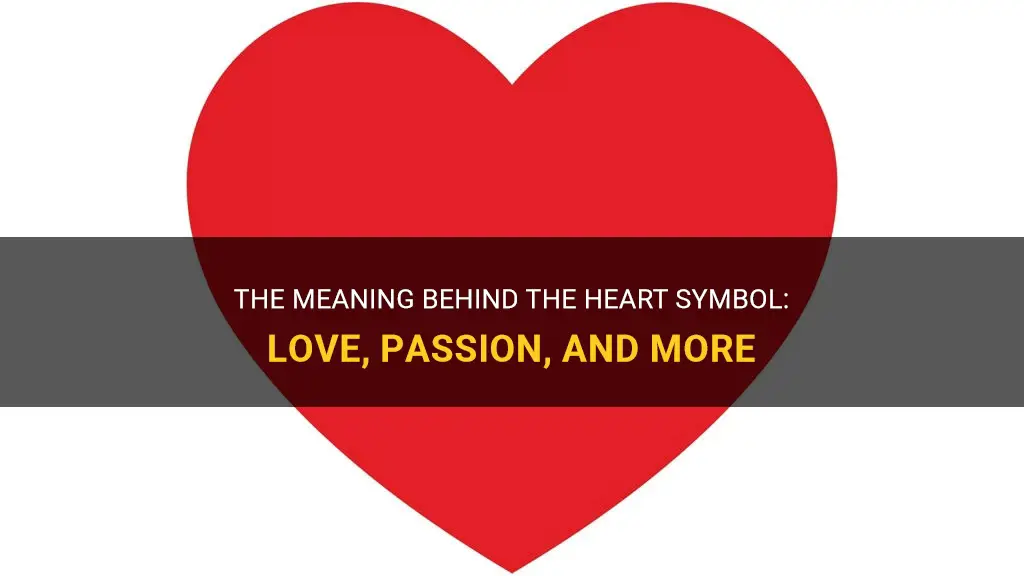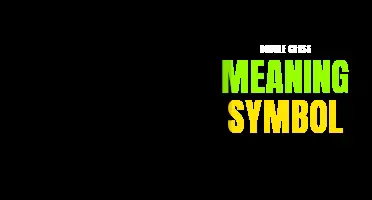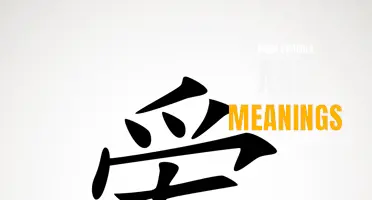
The heart symbol is universally recognized as a sign of love, affection, and emotions. It has become a powerful icon that transcends language and cultural barriers, representing the deepest connections and desires of the human heart. From ancient civilizations to modern times, the heart symbol has held various meanings, symbolizing not only romantic love but also kindness, compassion, and spirituality. This captivating symbol continues to evoke powerful emotions, reminding us of our capacity to love and be loved.
What You'll Learn
- What does the heart symbol traditionally symbolize?
- How has the meaning of the heart symbol evolved over time?
- Is the meaning of the heart symbol universal across different cultures and languages?
- What are some common uses of the heart symbol in popular culture today?
- Are there any other symbols that have a similar meaning to the heart symbol?

What does the heart symbol traditionally symbolize?
The heart symbol is one of the most recognized and universal symbols in the world. It has been used for centuries to represent various concepts and emotions, but its most common association is with love and affection. However, the heart symbol has a rich history and has been used in multiple cultural and religious contexts throughout time.
The heart as a symbol of love dates back to ancient times. The ancient Greeks believed that the heart was the center of all emotions, including love, and considered it the most important organ in the body. They even believed that the heart was the source of all wisdom and intellect.
In Christianity, the heart symbolizes Jesus Christ's divine love for humanity. The Sacred Heart of Jesus is depicted as a flaming heart, often crowned with thorns or pierced with a sword, representing the depth of his love and compassion for mankind.
In medieval times, the heart symbol became associated with courtly love and romanticism. It was often used in poetry, art, and literature to express the intensity of romantic love and devotion. The concept of the heart being the center of emotions and love spread throughout Europe during this period.
During the Renaissance, the heart symbol took on new meanings. It became associated with secrecy and confidentiality. In art, a hand holding a heart symbolized loyalty and trust. This notion of the heart as a symbol of trust and confidentiality can still be seen today in the "hand on heart" gesture, which is used to show sincerity and honesty.
In contemporary culture, the heart symbol has become synonymous with love, affection, and romance. It is widely used to represent these emotions in various forms, such as greeting cards, jewelry, and tattoos. The heart symbol is also used extensively in marketing and branding, as it instantly conveys a message of love and connection.
Aside from its association with love, the heart symbol is also used to represent courage, strength, and resilience. It is often used to honor and celebrate the bravery of individuals who have overcome obstacles or made a significant impact in their communities.
In conclusion, the heart symbol has a long history and diverse meanings. While it is most commonly associated with love and affection, its significance goes beyond romance. It represents a range of emotions, from deep compassion to bravery and resilience. The heart symbol continues to be a powerful and universal way to express emotions and connect with others all around the world.
Exploring the Symbolism and Meanings of Asian Tattoos: A Guide to Cultural Iconography
You may want to see also

How has the meaning of the heart symbol evolved over time?
The heart symbol is one of the most widely recognized symbols in the world. It is commonly associated with love, romance, and affection. However, the meaning of the heart symbol has evolved over time and has taken on different connotations across various cultures and eras.
The origins of the heart symbol can be traced back to ancient times. The ancient Egyptians believed that the heart was the center of emotions and the seat of the soul. They depicted the heart as a vessel or a container for the soul. In ancient Greece, the heart was associated with love and desire. The Greek philosopher Plato believed that the heart was the source of all emotions and feelings.
During the Middle Ages in Europe, the heart symbol began to be associated with romantic love. It was depicted as a stylized heart shape with a cleft at the top. This symbol was used to represent the physical heart, as well as the emotional and spiritual aspects of love.
In the 14th century, the heart symbol gained further popularity through the poetry of Geoffrey Chaucer and the writings of the French poet Guillaume de Machaut. These poets used the heart symbol to represent love and desire in their works. The heart symbol became a popular motif in art and literature during this time, and it continued to be associated with romantic love.
During the Renaissance period, the heart symbol started to be used in a more metaphorical sense. It became a symbol of not only romantic love but also of the virtues of charity, compassion, and empathy. The heart symbol was often depicted with flames or wings, representing the intensity and power of love.
In the 18th and 19th centuries, the heart symbol became increasingly associated with sentimental love and sentimentalism. It was featured in Valentine's Day cards and other romantic tokens. The heart symbol became more widely recognized as a symbol of love and affection during this time.
In modern times, the heart symbol has taken on a broader range of meanings. It has become a symbol of love in all its forms, including romantic love, familial love, and even self-love. The heart symbol is often used to represent compassion, kindness, and empathy. It has also become a symbol of solidarity and support, especially in the context of social justice movements.
The heart symbol has also become a popular symbol in popular culture. It is used in logos, advertisements, and branding to convey emotions such as love, happiness, and joy. The heart emoji has become one of the most widely used emojis in digital communication, often used to express love, affection, and appreciation.
Overall, the meaning of the heart symbol has evolved over time, but its association with love and affection has remained constant. From its origins in ancient civilizations to its modern-day usage, the heart symbol continues to be a powerful and universal symbol of love and compassion.
The Mystical Symbolism Behind the Planet Uranus
You may want to see also

Is the meaning of the heart symbol universal across different cultures and languages?
The heart symbol is one of the most widely recognized and commonly used symbols in the world. It is commonly associated with love, affection, and romance in many cultures and languages. However, the interpretation and meaning of the heart symbol can vary across different cultures and languages.
In Western cultures, the heart symbol has been used since ancient times to represent love and the emotional center of a person. It is commonly associated with Valentine's Day and is often used to express love and affection, especially in the context of romantic relationships. The heart symbol is also widely used to symbolize emotions such as compassion, kindness, and empathy.
In many Asian cultures, however, the heart symbol does not have the same connotations as it does in Western cultures. In some Asian languages, such as Chinese and Japanese, the heart symbol is more commonly associated with the physical organ rather than the emotional or romantic connotations. In fact, the symbol for love in these cultures is often represented by a character rather than a pictographic symbol.
Furthermore, the use of the heart symbol can also vary within different regions of the same culture or language. For example, in some Arab cultures, the heart symbol is not commonly used to represent love or romance. Instead, other symbols such as roses or poetic calligraphy are used to express these emotions. Similarly, in some African cultures, the heart symbol may have different meanings or interpretations depending on the specific cultural context.
It is important to note that the meaning of symbols can also change over time. With the globalization and spread of Western influence, the heart symbol has become more widely recognized and associated with love and romance in many cultures around the world. This is especially true in popular culture, where the heart symbol is often used in advertising, media, and art to convey emotions of love and affection.
In conclusion, while the heart symbol is generally associated with love and affection in Western cultures, its meaning can vary across different cultures and languages. In some cultures, the heart symbol may not have the same connotations or associations with love and romance. It is important to be aware of these cultural differences when using symbols to avoid misunderstandings and misinterpretations.
The Symbolic Meaning Behind Flickering Lights and What It Signifies
You may want to see also

What are some common uses of the heart symbol in popular culture today?
The heart symbol is one of the most recognized symbols in the world today. It is widely associated with love, affection, and romance. However, in addition to its traditional meaning, the heart symbol has also found its way into various aspects of popular culture. From social media to fashion, the heart symbol has become an iconic representation of emotions and aesthetics.
One of the most common uses of the heart symbol is in social media. Platforms such as Facebook, Instagram, and Twitter have incorporated the heart symbol as a way for users to express their approval or appreciation of a post. The "like" button on Facebook, which features a thumb in the shape of a heart, has become a symbol of validation and support. Similarly, on Instagram, users can "like" a post by tapping on a heart symbol beneath it. The heart symbol has thus become a universal symbol for expressing positive emotions and showing solidarity.
The heart symbol has also become popular in the fashion industry. It can be found on clothing, accessories, and jewelry. Heart-shaped necklaces, earrings, and bracelets are often used as a symbol of love and affection. The heart symbol has also been incorporated into various fashion logos and designs, adding a touch of femininity and romance to the overall aesthetic. In addition, the heart symbol is often used in greeting cards and gift items, further reinforcing its association with love and sentimentality.
In popular culture, the heart symbol is often used to convey deep emotional connections between characters in books, movies, and TV shows. It is a visual representation of love and romantic relationships. The heart symbol is frequently used in romantic comedies and dramas to signify the emotional bond between two characters. It is also used in advertisements and marketing campaigns to evoke feelings of love and desire, particularly in the beauty and fragrance industry.
The heart symbol has even made its way into the world of technology. It is commonly used in messaging apps and platforms as a way to express emotions. People often use heart emojis or stickers to convey love, happiness, or gratitude in their digital conversations. The heart symbol has become a shorthand for expressing emotions in a simple and visually appealing way.
In conclusion, the heart symbol is widely used across various aspects of popular culture today. It is not only a symbol of love and affection but also a representation of approval, support, and emotional connections. From social media to fashion, the heart symbol has become an iconic representation of emotions and aesthetics. Its widespread usage speaks to its universal appeal and its ability to communicate deep emotions and sentiments.
The Hidden Meanings Behind Snap Symbols Revealed
You may want to see also

Are there any other symbols that have a similar meaning to the heart symbol?
Yes, there are several other symbols that have a similar meaning to the heart symbol. Throughout history and across different cultures, the heart symbol has been used to represent love, affection, and emotion. However, it is important to note that the interpretations and usage of symbols can vary depending on the context and cultural background.
One symbol that is often associated with love and affection is the arrow. In mythology, Cupid is often depicted as a winged figure shooting arrows to make people fall in love. The arrow is seen as a representation of this act of love and desire. It is commonly used in combination with the heart symbol to signify romantic love.
Another symbol that is sometimes used in place of the heart symbol is the red rose. The rose has long been associated with love and has a romantic connotation. It is often given as a gift on special occasions to express deep affection and passion.
The infinity symbol (∞) is also commonly associated with love and everlasting affection. It represents an endless loop or connection, symbolizing the infinite nature of love. The infinity symbol is often used in jewelry and artwork to signify eternal love and commitment.
In some cultures, the dove is considered a symbol of love and peace. It is often depicted carrying an olive branch in its beak, representing harmony and reconciliation. The dove is seen as a symbol of pure love and is often used to signify devotion and fidelity.
Additionally, the Celtic love knot, also known as the trinity knot, is a symbol that represents interconnectedness and eternal love. It is created by intertwining a series of knots to form a continuous pattern. The Celtic love knot is often used in jewelry and artwork to convey everlasting love.
Symbols have the power to transcend language and convey deep emotions. While the heart symbol remains the most universally recognized symbol for love and affection, there are several other symbols that also carry similar meanings. The choice of symbol often depends on personal preference, cultural background, and the intended message.
Understanding HP Printer Symbols: What Do They Mean?
You may want to see also
Frequently asked questions
In modern culture, the heart symbol is widely recognized as a representation of love, affection, and romance. It is commonly used in various contexts, such as expressing love for someone, showing appreciation, or as a symbol of love in relationships.
The heart symbol has a rich historical meaning that dates back to ancient civilizations. It is believed to have originated from the ancient Greeks, who associated the heart with the seat of emotions and love. Over time, the heart symbol has evolved and become synonymous with love, compassion, and the core of human emotions.
Yes, the interpretation of the heart symbol can vary based on cultural contexts. While love and affection are universally associated with the heart symbol, the specific meaning can differ across cultures. For example, in some cultures, the heart symbol may be used to represent generosity or hospitality, while in others it may symbolize bravery or courage.
Although the heart symbol is primarily associated with love and affection, it can also have alternative meanings in different contexts. In the medical field, the heart symbol represents the actual organ and is used to symbolize healthcare and healing. Additionally, the heart symbol can also be used to convey support, unity, and compassion in various social and humanitarian causes.







